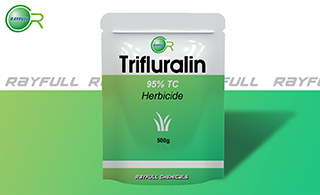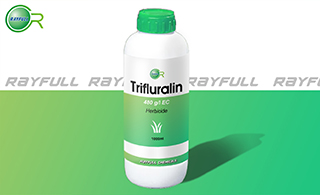Trifluralin
    氟乐灵 氟乐灵
Introduction: Trifluralin is a selective, preemergence dinitroaniline herbicide used to control many annual grasses and broadleaf weeds in a large variety of tree fruit, nut, vegetable, and grain crops. Preemergence herbicides are applied before weed seedlings sprout. Trifluralin should be incorporated into the soil by mechanical means within 24 hours of application. Granular formulations may be incorporated by overhead irrigation. Trifluralin is available in granular and emulsifiable concentrate formulations.
Common name: Trifluralin
Another name: Treflan; Agreflan; Elancolan; Tristar; Crisalin; Triflurex; Trifurex; Nitran; 2,6-Dinitro-N,N-dipropyl-4-(trifluoromethyl)aniline; Nitran K; Trifluraline; Crisalina; Digermin; Synfloran; Trefanocide; Treficon; etc.
Chemical name: α,α,α-trifluoro-2,6-dinitro-N,N-dipropyl-p-toluidine
Empirical formula: C13H16F3N3O4
Structural formula:

Mol. Weight: 335.28 g/mol
CAS No.: 1582-09-8
Specifications
Leading Trifluralin supplier
Trifluralin 95% TC
Trifluralin 480 g/L EC
Packing:
BULK PACKING
Powder: 25kg/Bag, 25kg/Drum, 50kg/Drum etc.
Liquid: 200L/Drum, 20L/Drum, 10L/Drum etc.
SMALL PACKING
Powder: 1kg/Alu bag, 500g/Alu bag, 200g/Alu bag, 100g/Alu bag, 50g/Alu bag, 15g/Alu bag etc.
Liquid: 5L/Drum, 1L/Bottle, 500ml/Bottle, 250ml/Bottle, 100ml/Bottle, 50ml/Bottle etc.
Customerized packing label
Trifluralin FAO standard
Professional registration
HAZARDS IDENTIFICATION
Hazard statement(s)
H302 (18.99%): Harmful if swallowed.
H317 (100%): May cause an allergic skin reaction.
H330 (18.99%): Fatal if inhaled.
H351 (97.77%): Suspected of causing cancer.
H400 (100%): Very toxic to aquatic life.
H410 (99.44%): Very toxic to aquatic life with long lasting effects.
Precautionary statement(s)
P201: Obtain special instructions before use.
P202: Do not handle until all safety precautions have been read and understood.
P260: Do not breathe dust/fume/gas/mist/vapors/spray.
P261: Avoid breathing dust/fume/gas/mist/vapors/spray.
P264: Wash ... thoroughly after handling.
P270: Do not eat, drink or smoke when using this product.
P273: Avoid release to the environment.
P280: Wear protective gloves/protective clothing/eye protection/face protection.
P301+P312: IF SWALLOWED: call a POISON CENTER/doctor/... IF you feel unwell.
P304+P340: IF INHALED: Remove person to fresh air and keep comfortable for breathing.
P308+P313: IF exposed or concerned: Get medical advice/attention.
P310: Immediately call a POISON CENTER or doctor/physician.
P321: Specific treatment (see ... on this label).
P330: Rinse mouth.
P333+P313: IF SKIN irritation or rash occurs: Get medical advice/attention.
P363: Wash contaminated clothing before reuse.
P391: Collect spillage.
P405: Store locked up.
P501: Dispose of contents/container to an approved waste disposal plant.
Supplemental Hazard Statements: none.
MAMMALIAN TOXICOLOGY
Acute toxicity: 1) Acute oral LD50 for rats is >5000 a.i.mg/kg. 2) Acute dermal LD50 for rats is >2000 a.i.mg/kg. 3) Acute inhalation toxicity LC50 (4 h) for rats is >1.252 a.i.mg/L. 4) Skin irritation: Non-irritating to skin (rabbits). 5) Eye irritation: Slightly irritating to eyes (rabbits). 6) Skin sensitization for guinea pig: Not sensitising.
NOEL: In 2 y feeding trials in rats, the only effect at the low dose of 813 mg/kg in diet was the formation of renal calculi. This has been shown to be reversible in a 90 d study in dogs, and a NOEL established at 2.4 mg/kg daily. Other Not genotoxic.
ADI 0-0.015 mg/kg b.w.
Classification:
WHO Classification: U (Unlikely to present an acute hazard )
EC Risk Classification: Carcinogen category 3: R40; Xn - Harmful: R43; N - Dangerous for the environment: R50, R53
US EPA Classification (formulation): III, IV (Caution - Slightly toxic, Caution - Not acutely toxic)
ECOTOXICOLOGY
Effect on birds: Acute oral LD50 for Bobwhite quail is >2250 a.i.mg/kg. Effect on fish: Acute LC50 (96 h) for Rainbow trout is 0.088 a.i.mg/l. Effects on aquatic invertebrates: Acute EC50 (48 h) for Daphnia magna is 0.245 a.i.mg/l. Effects on algae: Acute 72 hour EC50 for Raphidocelis subcapitata is 0.0122 a.i.mg/l. Effects on bees: contact acute 48 hour LD50 is >100 a.i.μg/bee, oral acute 48 hour LD50 is >100 a.i.μg/bee. Effects on earthworms: Acute 14 day LC50 is >500 a.i.mg/kg.
ENVIRONMENTAL FATE
Animals Degradation in animals is as for soil (J. L. Emmerson & R. C. Anderson, Toxicol. Appl. Pharmacol., 1966, 9, 84-97). Following oral administration, c. 70% is eliminated in the urine and 15% in the faeces within 72 h. Plants Degradation in plants is as for soil. Soil/Environment Adsorbed by the soil, and is extremely resistant to leaching. Little lateral movement in the soil. Metabolism involves dealkylation of the amino group, reduction of the nitro group to an amino group, partial oxidation of the trifluoromethyl group to a carboxy group, and subsequent degradation to smaller fragments (T. Golab et al., J. Agric. Food Chem., 1979, 27, 163); DT50 57-126 d. Duration of residual activity in soil is 6-8 mo. In laboratory studies, degradation was more rapid under anaerobic conditions, e.g. for loam soil, DT50 (anaerobic) 25-59 d, DT50 (aerobic) 116-201 d. Soil photolysis DT50 41 d; aqueous photolysis DT50 0.8 h. Koc 4400-40 000; Kd ranges from 3.75 (0.01% o.m., pH 6.6) to 639 (16.9% o.m., pH 6.8) (H. J. Pedersen et al., Pestic. Sci., 44, 131 (1995)).
Usage: Trifluralin was introduced by Eli Lilly & Co. (agrochemical interests now Dow AgroSciences). It is a pre-emergence soil-incorporated herbicide for use in various crops to control many annual grasses and broad-leaved weeds.
Application: Biochemistry Microtubule assembly inhibition. Mode of action Selective soil-herbicide, which acts by entering the seedling in the hypocotyl region. Also inhibits root development. Uses Pre-emergence control of many annual grasses and broad-leaved weeds in brassicas, beans, peas, carrots, parsnips, lettuce, capsicums, tomatoes, artichokes, onions, garlic, vines, strawberries, raspberries, citrus fruit, oilseed rape, peanuts, soya beans, sunflowers, safflowers, ornamentals, cotton, sugar beet, sugar cane, and in forestry. Used with linuron or isoproturon for control of annual grasses and broad-leaved weeds in winter cereals. Normally applied pre-planting with soil incorporation, at 0.5-1.0 kg/ha, but post-planting application is also possible for some crops.
| 






